Long TOYOTA BZ4X 2022 Owners Manual (in English)
[x] Cancel search | Manufacturer: TOYOTA, Model Year: 2022, Model line: BZ4X, Model: TOYOTA BZ4X 2022Pages: 674, PDF Size: 120.02 MB
Page 36 of 674
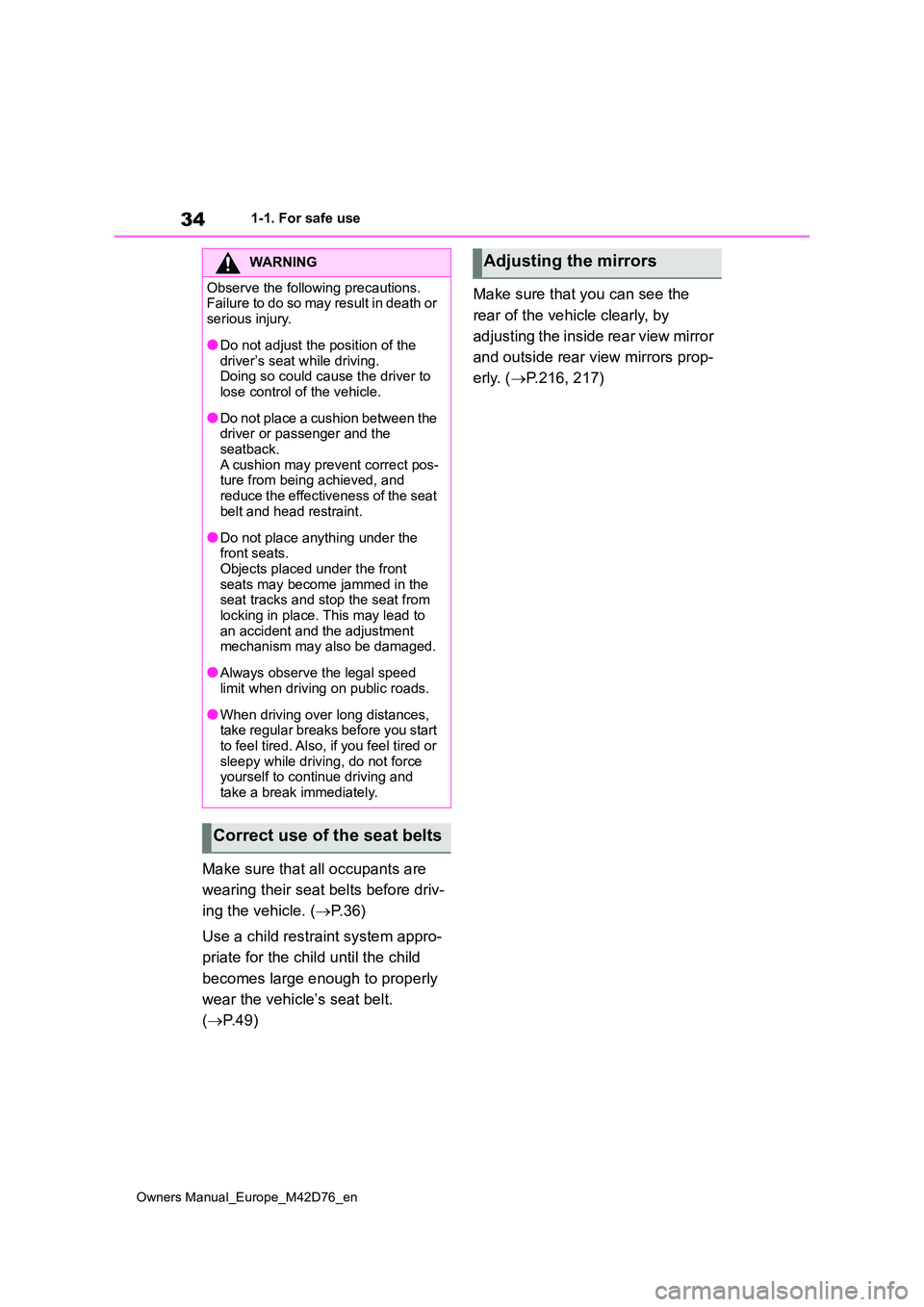
34
Owners Manual_Europe_M42D76_en
1-1. For safe use
Make sure that all occupants are
wearing their seat belts before driv-
ing the vehicle. ( P.36)
Use a child restraint system appro-
priate for the child until the child
becomes large enough to properly
wear the vehicle’s seat belt.
( P. 4 9 )
Make sure that you can see the
rear of the vehicle clearly, by
adjusting the inside rear view mirror
and outside rear view mirrors prop-
erly. ( P.216, 217)
WARNING
Observe the following precautions. Failure to do so may result in death or
serious injury.
●Do not adjust the position of the
driver’s seat while driving. Doing so could cause the driver to lose control of the vehicle.
●Do n ot p la ce a cu s hi on b et we en t he driver or passenger and the
seatback. A cushion may prevent correct pos-ture from being achieved, and
reduce the effectiveness of the seat belt and head restraint.
●Do not place anything under the front seats.Objects placed under the front
seats may become jammed in the seat tracks and stop the seat from locking in place. This may lead to
an accident and the adjustment mechanism may also be damaged.
●Always observe the legal speed limit when driving on public roads.
●When driving over long distances, take regular breaks before you start to feel tired. Also, if you feel tired or
sleepy while driving, do not force yourself to continue driving and take a break immediately.
Correct use of the seat belts
Adjusting the mirrors
Page 50 of 674

48
Owners Manual_Europe_M42D76_en
1-2. Child safety
WARNING
■When installing a child restraint system
For safety reasons, always install a child restraint system in a rear seat. In the event that the rear seat cannot be
used, the front seat can be used as long as the airbag manual on-off sys-tem is set to “OFF”.
If the airbag manual on-off system is left on, the strong impact of the airbag deployment (inflation) may cause
serious injury or even death.
■When a child restraint system is
not installed on the front passen- ger seat
Ensure that the airbag manual on-off
system is set to “ON”. If it is left off, the airbag may not deploy in the event of an accident,
which may result in serious injury or even death.
Riding with children
Observe the following precau-
tions when children are in the
vehicle.
Use a child restraint system
appropriate for the child, until
the child becomes large
enough to properly wear the
vehicle’s seat belt.
It is recommended that chil-
dren sit in the rear seats to
avoid accidental contact with
the steering wheel, wiper
switch, etc.
Use the rear door child-protec-
tor lock or the window lock
switch to avoid children open-
ing the door while driving or
operating the power window
accidentally. ( P.188, 221)
Do not let small children oper-
ate equipment which may
catch or pinch body parts,
such as the power window,
hood, back door, seats, etc.
WARNING
■When children are in the vehicle
Never leave children unattended in the vehicle, and never allow children to have or use the key.
Children may be able to start the vehi- cle or shift the vehicle into neutral. There is also a danger that children
may injure themselves by playing with the windows or other features of the vehicle. In addition, heat build-up or
extremely cold temperatures inside the vehicle can be fatal to children.
Page 73 of 674

71
1
Owners Manual_Europe_M42D76_en
1-3. Emergency assistance
For safety and security
2.4. Arrangements for data processing
2.4.1.
The 112-based eCall in-vehicle system is
designed in such a way as to ensure that the
data contained in the system memory is not
available outside the system before an eCall is
triggered. Additional remarks (if any):
O
2.4.2.
The 112-based eCall in-vehicle system is
designed in such a way as to ensure that it is not
traceable and not subject to any constant track-
ing in its normal operation status. Additional
remarks (if any):
O
2.4.3.
The 112-based eCall in-vehicle system is
designed in such a way as to ensure that data in
the system internal memory is automatically and
continuously removed.
O
2.4.3.1.
The vehicle location data is constantly overwrit-
ten in the internal memory of the system so as
always to keep maximum of the last three up-to-
date locations of the vehicle necessary for the
normal functioning of the system.
O
2.4.3.2.
The log of activity data in the 112-based eCall in-
vehicle system is kept for no longer than neces-
sary for attaining the purpose of handling the
emergency eCall and in any case not beyond 13
hours from the moment an emergency eCall was
initiated.
O
Implementing Regulation Annex1 PART3 User InformationConformity
Page 85 of 674
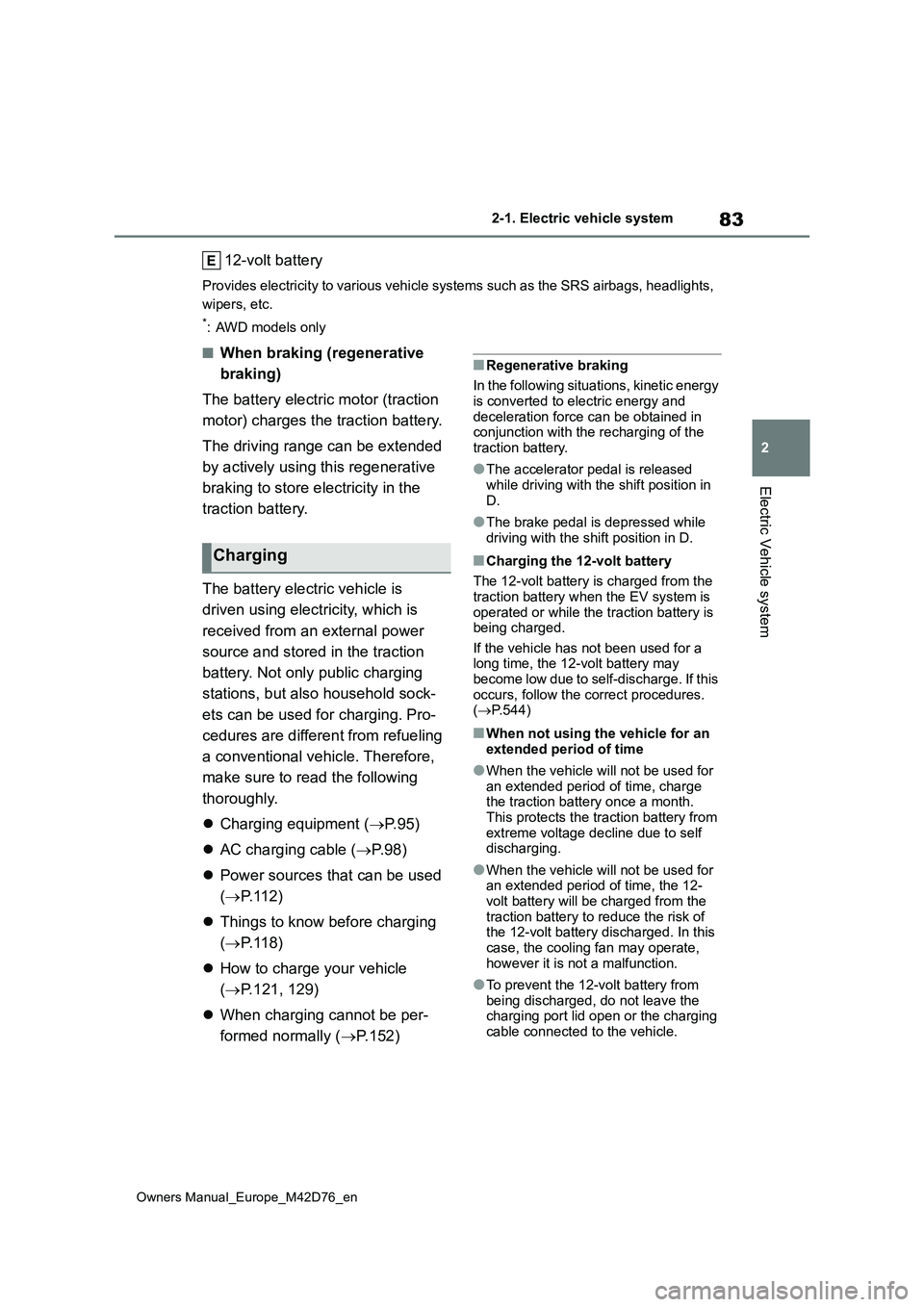
83
2
Owners Manual_Europe_M42D76_en
2-1. Electric vehicle system
Electric Vehicle system
12-volt battery
Provides electricity to various vehicle systems such as the SRS airbags, headlights,
wipers, etc.
*: AWD models only
■When braking (regenerative
braking)
The battery electric motor (traction
motor) charges the traction battery.
The driving range can be extended
by actively using this regenerative
braking to store electricity in the
traction battery.
The battery electric vehicle is
driven using electricity, which is
received from an external power
source and stored in the traction
battery. Not only public charging
stations, but also household sock-
ets can be used for charging. Pro-
cedures are different from refueling
a conventional vehicle. Therefore,
make sure to read the following
thoroughly.
Charging equipment (P.95)
AC charging cable (P. 9 8 )
Power sources that can be used
( P.112)
Things to know before charging
( P.118)
How to charge your vehicle
( P.121, 129)
When charging cannot be per-
formed normally ( P.152)
■Regenerative braking
In the following situations, kinetic energy
is converted to electric energy and deceleration force can be obtained in conjunction with the recharging of the
traction battery.
●The accelerator pedal is released
while driving with the shift position in D.
●The brake pedal is depressed while driving with the shift position in D.
■Charging the 12-volt battery
The 12-volt battery is charged from the
traction battery when the EV system is operated or while the traction battery is being charged.
If the vehicle has not been used for a long time, the 12-volt battery may become low due to self-discharge. If this
occurs, follow the correct procedures. ( P.544)
■When not using the vehicle for an
extended period of time
●When the vehicle will not be used for
an extended period of time, charge the traction battery once a month. This protects the traction battery from
extreme voltage decline due to self discharging.
●When the vehicle will not be used for an extended period of time, the 12-volt battery will be charged from the
traction battery to reduce the risk of the 12-volt battery discharged. In this case, the cooling fan may operate,
however it is not a malfunction.
●To prevent the 12-volt battery from
being discharged, do not leave the charging port lid open or the charging cable connected to the vehicle.
Charging
Page 93 of 674

91
2
Owners Manual_Europe_M42D76_en
2-1. Electric vehicle system
Electric Vehicle system
Shift the shift position to D when
stopped at a traffic light, or driving
in heavy traffic, etc. Shift the shift
position to P when parking. When
shifting the shift position to N while
driving, there is no positive effect
on electricity consumption. In the N,
the traction battery cannot be
charged. Also, when using the air
conditioning system, etc., the trac-
tion battery electricity is consumed.
( P.248)
Repeated acceleration and decel-
eration due to traffic congestion,
long waits at traffic lights, and driv-
ing on steep inclines will lead to
poor electricity consumption. In
order to avoid those situations as
much as possible, check traffic
reports before leaving. If the vehicle
is driven in traffic congestion, gently
release the brake pedal to allow the
vehicle to move forward slightly,
avoid overuse of the accelerator
pedal. Doing so can help minimize
unnecessary electricity consump-
tion.
Make sure to operate the brakes
gently and a timely manner. A
greater amount of electrical energy
can be regenerated when slowing
down.
Control and maintain the vehicle at
a constant speed. Before stopping
at a toll booth or similar, allow
plenty of time to release the accel-
erator and gently apply the brakes.
A greater amount of electrical
energy can be regenerated when
slowing down.
Batter y Electric Vehicle
driving tips
Unlike the conventional vehi-
cles, the electricity consump-
tion efficiency of battery
electric vehicles will decline if
they continue driving on high-
ways (or freeways) or at high
average speeds, causing the
possible driving distance to
reduce. Therefore, if the
remaining charge of the trac-
tion battery is low, avoid rely-
ing on the displayed possible
driving distance too much as
well as driving on highways (or
freeways). Driving the vehicle
at moderate speeds, the trac-
tion battery’s electricity con-
sumption can be controlled.
The following driving tips will
contribute to reduction in the
battery consumption and
increase in the driving range.
Shift position operation
Delays
When braking
Highway (or freeways) driv-
ing
Page 109 of 674
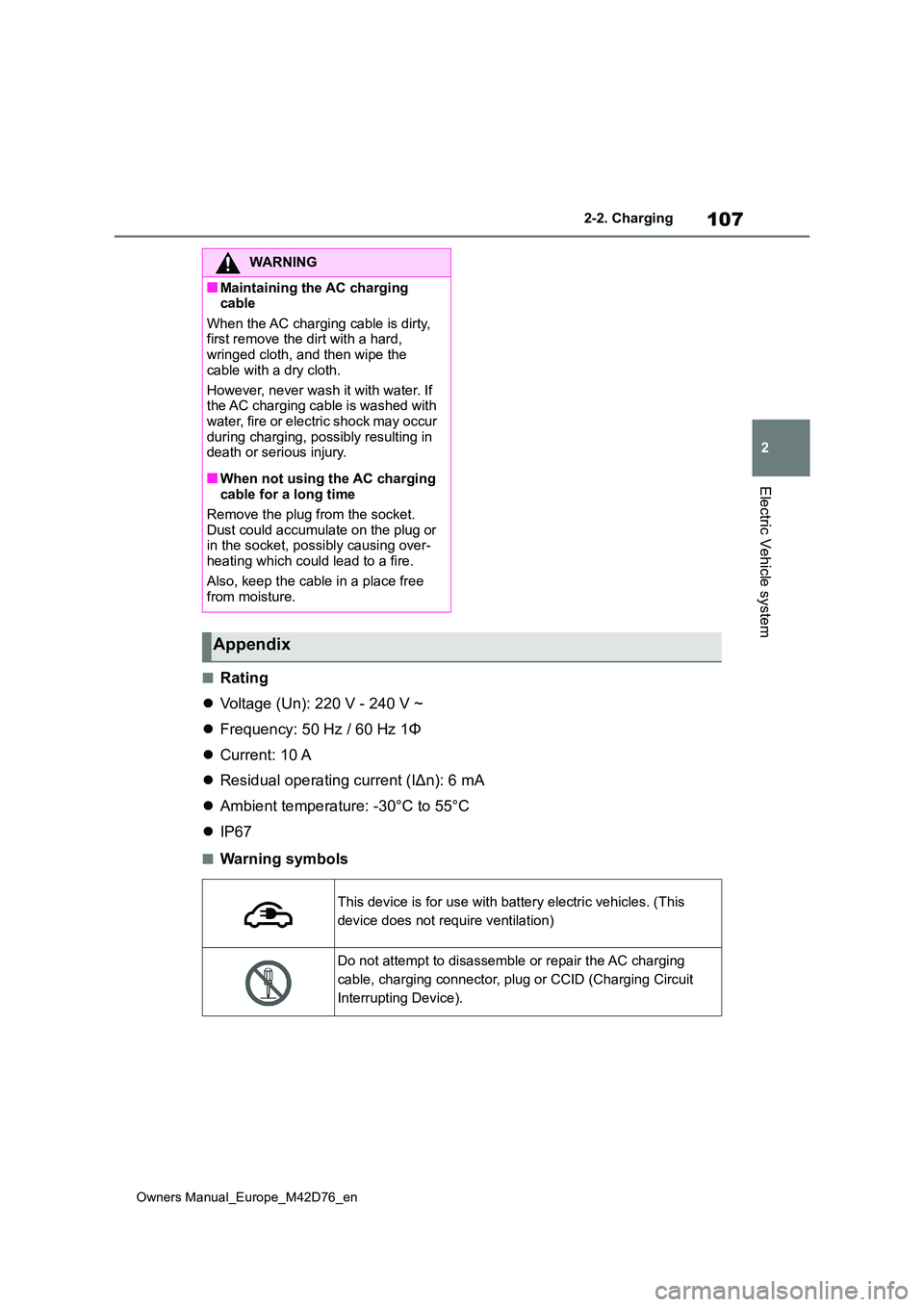
107
2
Owners Manual_Europe_M42D76_en
2-2. Charging
Electric Vehicle system
■Rating
Voltage (Un): 220 V - 240 V ~
Frequency: 50 Hz / 60 Hz 1Φ
Current: 10 A
Residual operating current (IΔn): 6 mA
Ambient temperature: -30°C to 55°C
IP67
■Warning symbols
WARNING
■Maintaining the AC charging cable
When the AC charging cable is dirty, first remove the dirt with a hard, wringed cloth, and then wipe the
cable with a dry cloth.
However, never wash it with water. If the AC charging cable is washed with
water, fire or electric shock may occur during charging, possibly resulting in death or serious injury.
■When not using the AC charging cable for a long time
Remove the plug from the socket. Dust could accumulate on the plug or in the socket, possibly causing over-
heating which could lead to a fire.
Also, keep the cable in a place free from moisture.
Appendix
This device is for use with battery electric vehicles. (This
device does not require ventilation)
Do not attempt to disassemble or repair the AC charging
cable, charging connector, plug or CCID (Charging Circuit
Interrupting Device).
Page 117 of 674
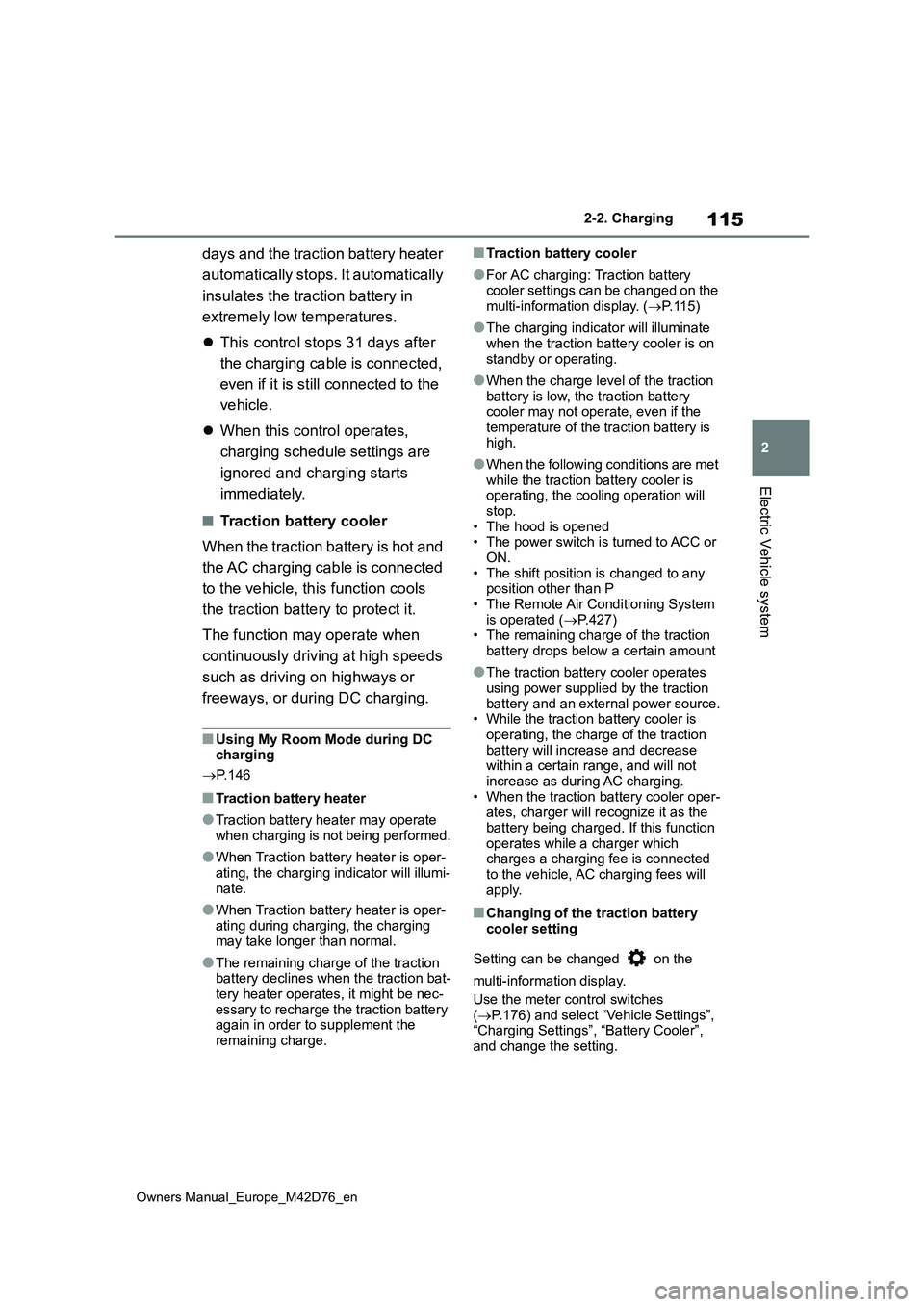
115
2
Owners Manual_Europe_M42D76_en
2-2. Charging
Electric Vehicle system
days and the traction battery heater
automatically stops. It automatically
insulates the traction battery in
extremely low temperatures.
This control stops 31 days after
the charging cable is connected,
even if it is still connected to the
vehicle.
When this control operates,
charging schedule settings are
ignored and charging starts
immediately.
■Traction battery cooler
When the traction battery is hot and
the AC charging cable is connected
to the vehicle, this function cools
the traction battery to protect it.
The function may operate when
continuously driving at high speeds
such as driving on highways or
freeways, or during DC charging.
■Using My Room Mode during DC charging
P. 1 4 6
■Traction battery heater
●Traction battery heater may operate when charging is not being performed.
●When Traction battery heater is oper-ating, the charging indicator will illumi-
nate.
●When Traction battery heater is oper-
ating during charging, the charging may take longer than normal.
●The remaining charge of the traction battery declines when the traction bat-tery heater operates, it might be nec-
essary to recharge the traction battery again in order to supplement the remaining charge.
■Traction battery cooler
●For AC charging: Traction battery cooler settings can be changed on the
multi-information display. ( P.115)
●The charging indicator will illuminate
when the traction battery cooler is on standby or operating.
●When the charge level of the traction battery is low, the traction battery cooler may not operate, even if the
temperature of the traction battery is high.
●When the following conditions are met while the traction battery cooler is operating, the cooling operation will
stop. • The hood is opened• The power switch is turned to ACC or
ON. • The shift position is changed to any position other than P
• The Remote Air Conditioning System is operated ( P.427) • The remaining charge of the traction
battery drops below a certain amount
●The traction battery cooler operates
using power supplied by the traction battery and an external power source.• While the traction battery cooler is
operating, the charge of the traction battery will increase and decrease within a certain range, and will not
increase as during AC charging. • When the traction battery cooler oper-ates, charger will recognize it as the
battery being charged. If this function operates while a charger which charges a charging fee is connected
to the vehicle, AC charging fees will apply.
■Changing of the traction battery cooler setting
Setting can be changed on the
multi-information display.
Use the meter control switches
( P.176) and select “Vehicle Settings”, “Charging Settings”, “Battery Cooler”, and change the setting.
Page 119 of 674
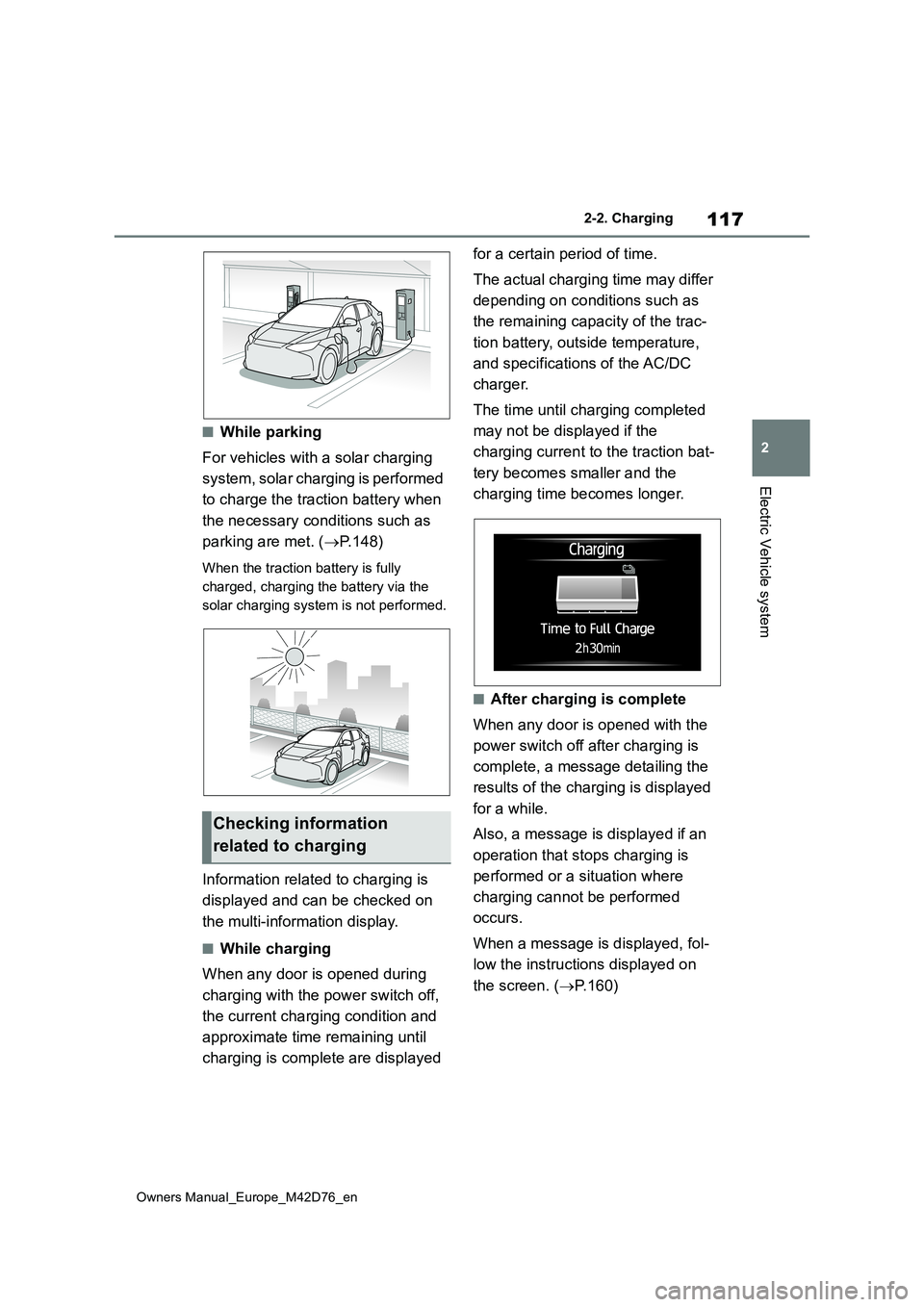
117
2
Owners Manual_Europe_M42D76_en
2-2. Charging
Electric Vehicle system
■While parking
For vehicles with a solar charging
system, solar charging is performed
to charge the traction battery when
the necessary conditions such as
parking are met. ( P.148)
When the traction battery is fully
charged, charging the battery via the
solar charging system is not performed.
Information related to charging is
displayed and can be checked on
the multi-information display.
■While charging
When any door is opened during
charging with the power switch off,
the current charging condition and
approximate time remaining until
charging is complete are displayed
for a certain period of time.
The actual charging time may differ
depending on conditions such as
the remaining capacity of the trac-
tion battery, outside temperature,
and specifications of the AC/DC
charger.
The time until charging completed
may not be displayed if the
charging current to the traction bat-
tery becomes smaller and the
charging time becomes longer.
■After charging is complete
When any door is opened with the
power switch off after charging is
complete, a message detailing the
results of the charging is displayed
for a while.
Also, a message is displayed if an
operation that stops charging is
performed or a situation where
charging cannot be performed
occurs.
When a message is displayed, fol-
low the instructions displayed on
the screen. ( P.160)
Checking information
related to charging
Page 120 of 674
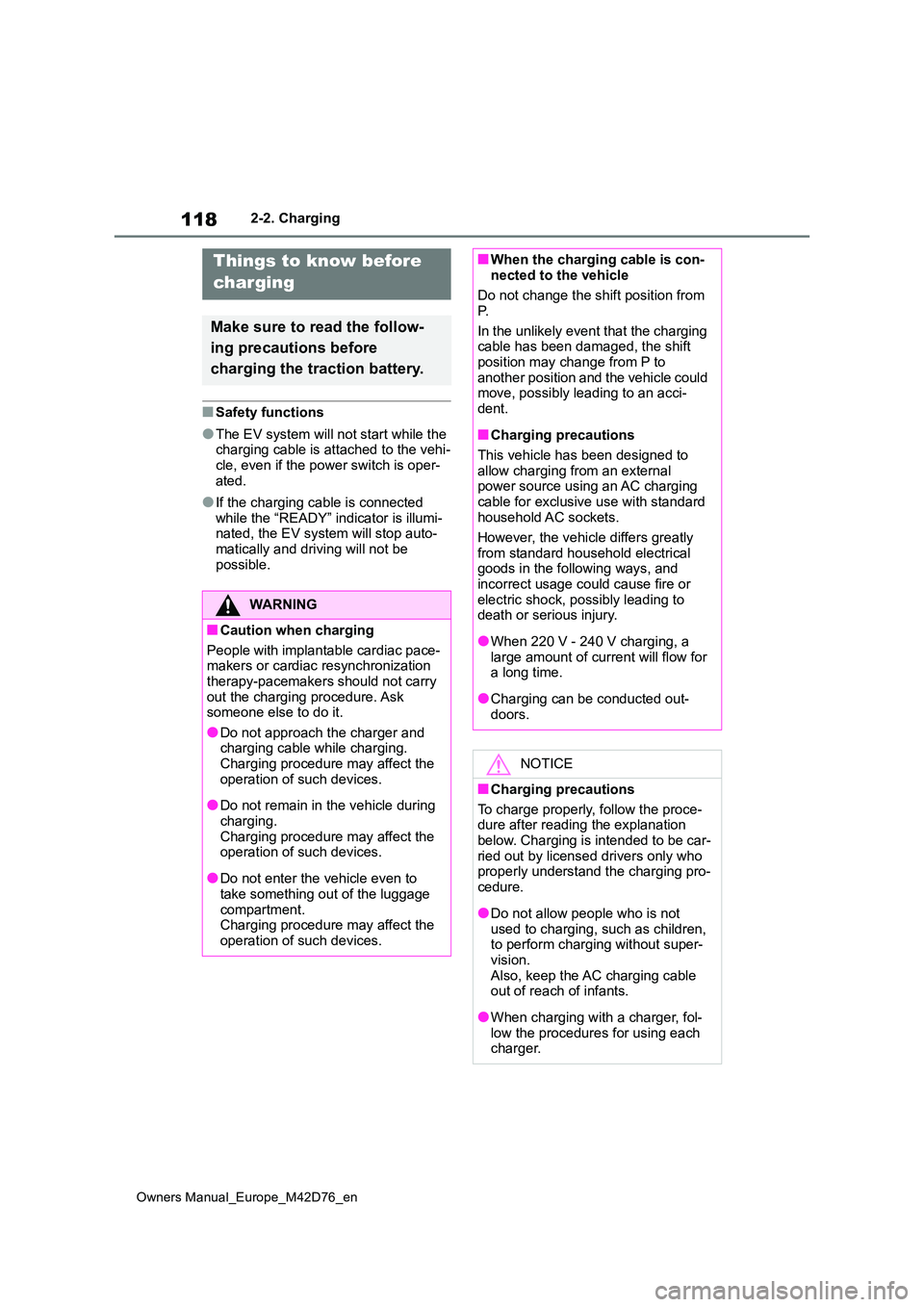
118
Owners Manual_Europe_M42D76_en
2-2. Charging
■Safety functions
●The EV system will not start while the charging cable is attached to the vehi-
cle, even if the power switch is oper- ated.
●If the charging cable is connected while the “READY” indicator is illumi-nated, the EV system will stop auto-
matically and driving will not be possible.
Things to know before
charging
Make sure to r ead the follow-
ing precautions before
charging the traction battery.
WARNING
■Caution when charging
People with implantable cardiac pace- makers or cardiac resynchronization
therapy-pacemakers should not carry out the charging procedure. Ask someone else to do it.
●Do not approach the charger and charging cable while charging. Charging procedure may affect the
operation of such devices.
●Do not remain in the vehicle during
charging. Charging procedure may affect the operation of such devices.
●Do not enter the vehicle even to take something out of the luggage
compartment. Charging procedure may affect the operation of such devices.
■When the charging cable is con-nected to the vehicle
Do not change the shift position from
P.
In the unlikely event that the charging cable has been damaged, the shift
position may change from P to another position and the vehicle could move, possibly leading to an acci-
dent.
■Charging precautions
This vehicle has been designed to allow charging from an external power source using an AC charging
cable for exclusive use with standard household AC sockets.
However, the vehicle differs greatly
from standard household electrical goods in the following ways, and incorrect usage could cause fire or
electric shock, possibly leading to death or serious injury.
●When 220 V - 240 V charging, a large amount of current will flow for a long time.
●Charging can be conducted out-doors.
NOTICE
■Charging precautions
To charge properly, follow the proce- dure after reading the explanation
below. Charging is intended to be car- ried out by licensed drivers only who properly understand the charging pro-
cedure.
●Do not allow people who is not
used to charging, such as children, to perform charging without super-vision.
Also, keep the AC charging cable out of reach of infants.
●When charging with a charger, fol-low the procedures for using each charger.
Page 122 of 674
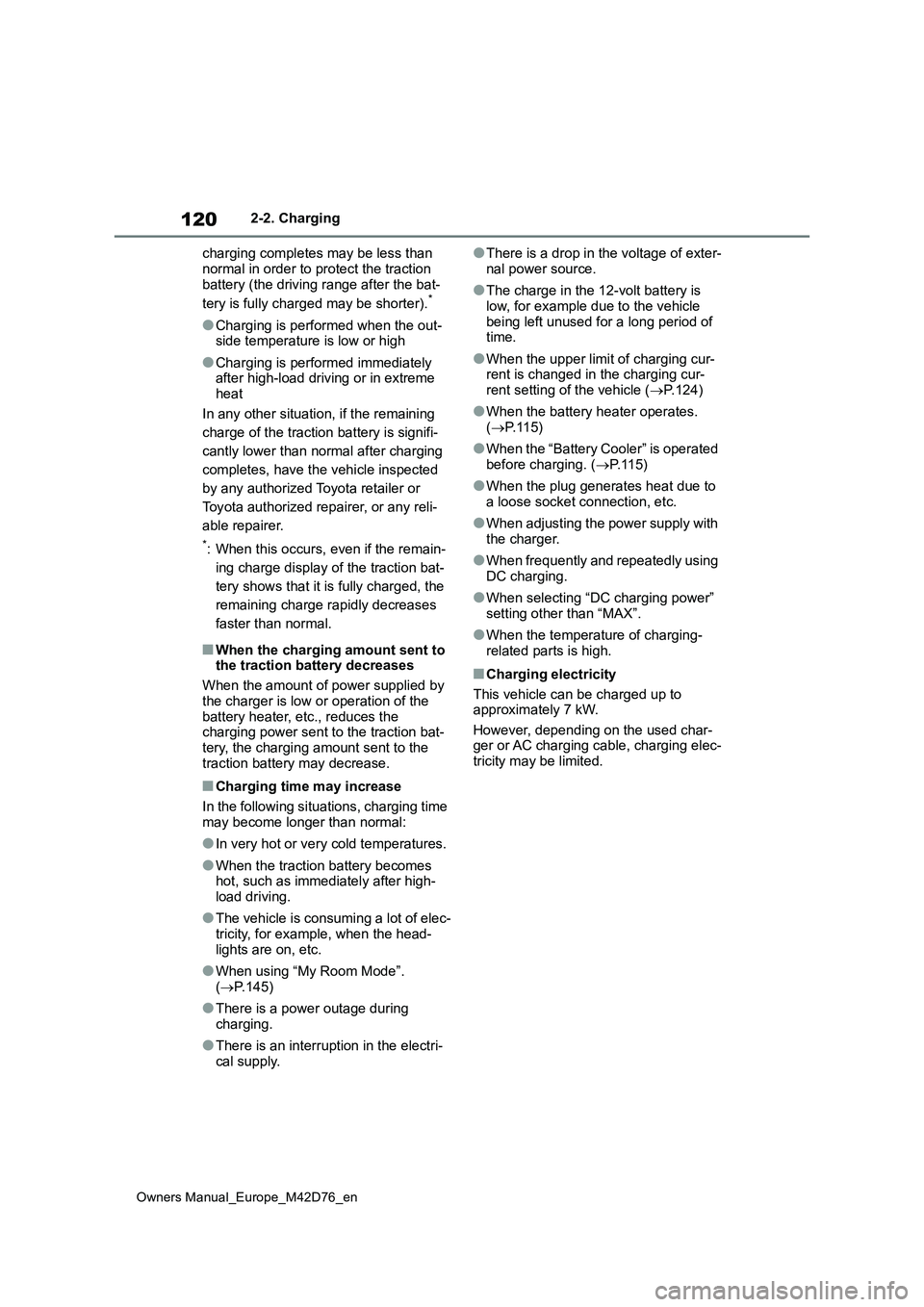
120
Owners Manual_Europe_M42D76_en
2-2. Charging
charging completes may be less than
normal in order to protect the traction battery (the driving range after the bat-
tery is fully charged may be shorter).*
●Charging is performed when the out- side temperature is low or high
●Charging is performed immediately after high-load driving or in extreme
heat
In any other situation, if the remaining
charge of the traction battery is signifi-
cantly lower than normal after charging
completes, have the vehicle inspected
by any authorized Toyota retailer or
Toyota authorized repairer, or any reli-
able repairer.
*: When this occurs, even if the remain-
ing charge display of the traction bat-
tery shows that it is fully charged, the
remaining charge rapidly decreases
faster than normal.
■When the charging amount sent to the traction battery decreases
When the amount of power supplied by
the charger is low or operation of the battery heater, etc., reduces the charging power sent to the traction bat-
tery, the charging amount sent to the traction battery may decrease.
■Charging time may increase
In the following situations, charging time
may become longer than normal:
●In very hot or very cold temperatures.
●When the traction battery becomes hot, such as immediately after high-
load driving.
●The vehicle is consuming a lot of elec-
tricity, for example, when the head- lights are on, etc.
●When using “My Room Mode”. ( P.145)
●There is a power outage during charging.
●There is an interruption in the electri-cal supply.
●There is a drop in the voltage of exter-
nal power source.
●The charge in the 12-volt battery is
low, for example due to the vehicle being left unused for a long period of time.
●When the upper limit of charging cur-rent is changed in the charging cur-
rent setting of the vehicle ( P.124)
●When the battery heater operates.
( P. 1 1 5 )
●When the “Battery Cooler” is operated
before charging. ( P. 1 1 5 )
●When the plug generates heat due to
a loose socket connection, etc.
●When adjusting the power supply with
the charger.
●When frequently and repeatedly using
DC charging.
●When selecting “DC charging power”
setting other than “MAX”.
●When the temperature of charging-
related parts is high.
■Charging electricity
This vehicle can be charged up to approximately 7 kW.
However, depending on the used char- ger or AC charging cable, charging elec-tricity may be limited.